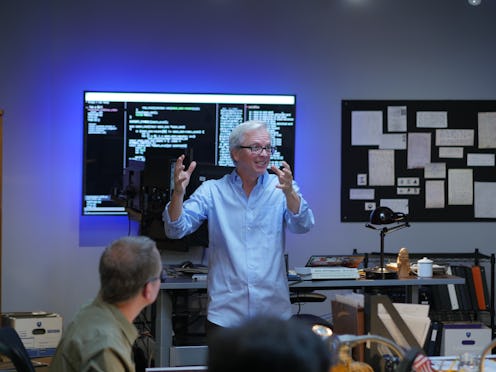Entertainment
This New Show May Have Finally Figured Out How The Zodiac Killer Got His Name

The Zodiac killer's murder spree across Northern California ended decades ago, but given the fact that he was never caught, the mystery that shrouds his identity and his motive still puzzles both investigators and amateur sleuths to this day. History Channel's new show, The Hunt for the Zodiac Killer, hopes to both recap what common knowledge exists about the murderer as well as introduce new evidence and answer new questions. One of those questions is, how did the Zodiac killer get his name?
First things first: the killer referred to himself as that name in the letters he sent to the media and police, he wasn't given it by anyone else. It was also accompanied by a cryptic symbol in his correspondence — a circle with a horizontal line and a vertical line drawn through it — looking almost like cross-hairs. As pointed out by Watchismo, a blog dedicated to watches and other timepieces, the symbol is identical to the logo used by Zodiac watches. The brand of watches, according to its website, was founded in the late 1800s, so definitely not named for the killer (and, granted, it would be an odd choice for a company looking to make an honest profit to name itself after a serial killer). David Fincher's 2007 film Zodiac, which dramatizes the events of the killing spree and subsequent investigation, also has a scene in which Arthur Leigh Allen, a real-life suspect in the case, shows investigators his Zodiac brand watch. Despite this connection, according to a 2002 San Francisco Chronicle article, Allen died in 1992 and his DNA was never found to be a match to that found on the killer's many letters.
The History Channel's show introduces some interesting new information to how the killer could have potentially gotten his name. The show's investigators find out that just a few blocks from the apartment of Ross Sullivan — another potential Zodiac suspect — there was a stationery shop, Palace Stationers, which was advertising "Zodiac" stationery at the same time Sullivan would have lived there. At first, they think it could just be "interesting circumstantial evidence," as one of them puts it. This isn't really a well-known theory that people have heard hundreds of times, like many theories surrounding the Zodiac killer are, and as investigators pointed out, the only real, solid and true connection is that the stationery store where this Zodiac product was being sold happened to exist in the same town as one of the potential suspects. That stationery could've been sold in plenty of towns where plenty of bad things happened, in which case this could be dismissed as a creepy coincidence. But there's more.
In some of the advertisements, the owners of the store choose to write the store's name in an almost crossword puzzle fashion. "Palace" is written horizontally, and "Stationers" is written vertically, with the two words intersecting at the "A." A simple enough design choice, but it has a chilling connection. This criss-cross manner of formatting the words is nearly identical to the style the Zodiac killer used when he mailed a Halloween card to the San Francisco Chronicle, according to the show. It also reminded the show's investigators of certain codes and ciphers that the killer would include in his letters, and that many have tried to crack.
No matter what these sleuths prove to uncover, one thing is certain: The Zodiac killer must have known what he was doing. It's hard to believe that a criminal who put this much time into cultivating hard-to-crack codes and toying with the media and authorities so much would make any choice lightly or without reason. The name "Zodiac" likely holds meaning of some kind, but given the years that have passed since the murder and the fact that some of the most promising suspects are dead, enthusiasts of the case will continue to dig for clues for quite some time.